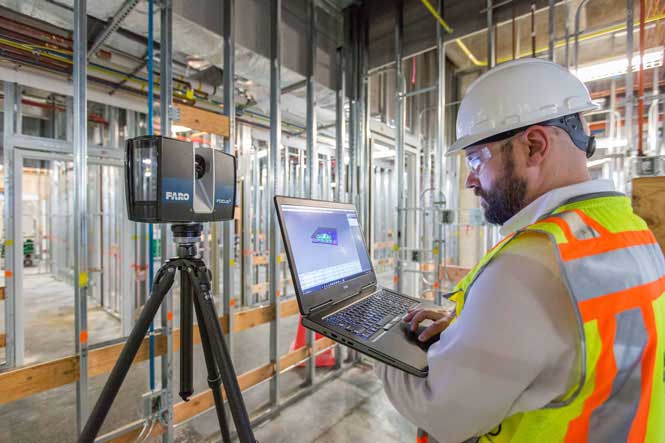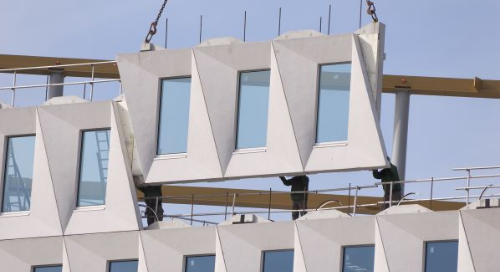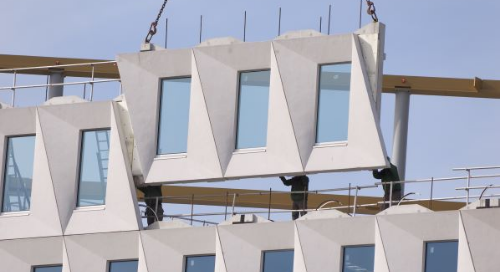With the emergence of new 3D technology accelerating change across all industries, its use in prefabrication manufacturing is changing the construction landscape. Scott Diaz, Director of Business Development at FARO®, offers his perspective on what companies need to know about implementing prefabrication manufacturing.
Q: Let’s start with the obvious question: what is prefabrication?
A: Prefabrication, or prefab for short, is manufacturing individual components to be assembled in a factory and shipped to a site, instead of being built manually on site. It’s also called “off-site” or “modular” construction. A lot of diverse industries use prefab manufacturing. Steel, timber, precast — including concrete — all use prefab. Modular housing is a huge industry that uses prefabrication.
Q: Thinking about everything involved in construction project lifecycle, what’s the most overlooked benefit of integrating prefabrication?
A: There’s consistency in the process. When you’re building something manually on site, the same part may be built slightly differently each time. The more error in the process, the further away you stray from design intent. And that’s the same consideration with construction QC as well. The reason we scan as we build new buildings is to verify we’re in line with our tolerances and that we’ve stayed aligned with the architect’s original design model.
By building off site in a controlled environment we can follow a more standard process. We don’t have to deal with changes in the elements or human variation. Even before the product leaves the warehouse, we can measure the final module to verify it’s ready to ship, so there’s no surprises when we’re assembling on site. The standardization is built into everything, so there are far fewer mistakes. And fewer mistakes means more savings, less waste and more safety.
Q: You mentioned safety. How does prefabrication address safety concerns in the construction industry?
A: Now you’re taking tradespeople that would normally be assembling modules on site and putting them on an assembly line in a safe environment, rather than on the thirtieth story of a skyscraper, for example. The fewer bodies you have to manage in that kind of environment, the better. It’s taking people out of a more dangerous environment and putting them into a more controlled, safer one. The construction industry takes safety very seriously and prefab is a big part of making the work safer.
Q: Prefab also carries other benefits. There’s research that points to prefabrication as an important part of “green” building efforts.
A: Absolutely. When you reduce scrap and rework waste, that’s less trash. When you’re completing off-site construction in less time, that’s less energy consumption, which reduces carbon emissions. Prefabrication smooths the way for some projects to include environmentally friendly components as well. It’s definitely a benefit.
Q: Having worked with several companies adopting prefab, what did you see them grapple with during the integration?
A: What I’ve learned is that prefab is still a new thing in the construction industry. We’ve been doing it in manufacturing for a long time, but it’s just starting to grow in construction… the industry is adopting new tech pretty rapidly as a whole. So, companies can be surprised by how long it takes to fully develop the prefab process, to the point that they may lose a little money at first until their process is fully refined.
Because there isn’t one set-in-stone way to implement, companies need to take a little extra time at the beginning to figure it out. Once they do, the ROI is there. Project schedules alone can be accelerated by months without sacrificing quality output.
Q: How can companies overcome those initial growing pains?
A:We work with the early adopters, such as Skender Construction, that are open to adopting new practices and want to be the first to do it. We’re able to learn alongside them in a kind of testing environment. We can take those lessons and bring them to other companies who are becoming interested in adopting prefab, and the early adopters benefit from getting ahead of the game.
We are 100% open to working with new partners. We often leverage our 35 plus years of internal expertise in 3D manufacturing… there are a lot of applicable best practices for integrating prefab that we can adapt and bring to our construction customers.
Q: The construction industry is going to face a skilled worker shortage at the same time it’s beginning to adopt this technique. How can the construction workforce stabilize while keeping pace with advances in technology?
A: We have a responsibility to respond to these changes. It’s true that there are fewer “unicorns” these days – the skilled tradespeople who can stand on a site and measure with their thumb and get it right – and that’s not a skill we can replicate. That’s thirty years of experience talking. And they are getting older, retiring, leaving the industry…
So, how can we take that person’s knowledge and transfer it to the next generation? There’s an opportunity for us to help companies prioritize adoption and training of new technology for incoming workers and combine it with the hard-won wisdom from the “old guard”, giving us the best of both worlds.
Q: What questions do you wish companies would ask about prefab?
A: I think it would benefit companies to ask, “What should I be prefabricating instead of building on site, because it would save me time, or money, or be safer, or make a better overall product, or all of the above?” And then, if a company has decided to move forward, “Who can help me make my processes more efficient, consistent and accurate?”
We love working with companies who want to explore these questions. We’ll work with the information they give us to determine what resources and expertise we can offer, and we also use their feedback to determine ideas for new development directions.
Q: What should companies look for in a partner once they decide to start with prefab?
A: Companies should look for partners who want to progress the construction industry with them, who want to have an ongoing relationship with them, who are learning from each other to push the technology forward. Partners who can offer advising and consulting long-term will provide the best overall return on investment, because the company gains not just the current technology, but access to the next iteration and the assistance and training that comes with it.


